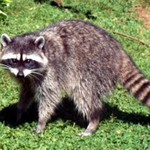 KASSEL, Germany — In 1934, top Nazi Party official Hermann Goering received a seemingly mundane request from the Reich Forestry Service. A fur farm near here was seeking permission to release a batch of exotic bushy-tailed critters into the wild to "enrich the local fauna" and give bored hunters something new to shoot at.
KASSEL, Germany — In 1934, top Nazi Party official Hermann Goering received a seemingly mundane request from the Reich Forestry Service. A fur farm near here was seeking permission to release a batch of exotic bushy-tailed critters into the wild to "enrich the local fauna" and give bored hunters something new to shoot at.Goering approved the request and unwittingly uncorked an ecological disaster that is still spreading across Europe.
The imported North American species, Procyon lotor, or the common raccoon, quickly took a liking to the forests of central Germany. Encountering no natural predators — and with hunters increasingly called away by World War II — the woodland creatures multiplied.
Wildlife biologists say the problem was aggravated by the release of raccoons from other farms that sustained bomb damage during World War II.
Today, as many as 1 million raccoons are estimated to live in Germany, and their numbers are steadily increasing. In 2005, hunters and speeding cars killed 10 times as many raccoons as a decade earlier, according to official statistics.
Raccoons have crawled across the border to infest each of Germany's neighbors and now range from the Baltic Sea to the Alps. Scientists say they have been spotted as far east as Chechnya.
British tabloids have warned that it's only a matter of time until the "Nazi raccoons" cross the English Channel.
For the most part, the raccoons haven't disrupted the natural order of things in the forests, although some people blame them for reducing the number of songbirds by stealing eggs from their nests. Rather, the biggest impact has been on humans.
Complaints are soaring about fearless raccoons that penetrate homes and destroy property, saddling owners with expensive repair bills and hard-to-dislodge pests.
The Germans call them Waschbaeren, or "wash bears," because they habitually wash their paws and douse their food in water. And no place in Germany has more of them than Kassel, a city of about 200,000 people in the central state of Hesse.
For the mask-faced mammals, it has plenty of leafy suburban backyards that border large tracts of public forests.
Five years ago, a family of raccoons scratched and munched their way into a house belonging to Ingrid and Dieter Hoffmann of Kassel. The brood settled into the Hoffmanns' chimney and — despite efforts to smoke them out — ruined their roof, which cost tens of thousands of dollars to fix.
"The little ones look cute and have a pretty face," said Ingrid Hoffmann, 70. "But their mother can bite your finger off."
Dieter Hoffmann wagged an accusing finger at a visitor: "We like the United States of America, but we do not like your Waschbaeren!"
For now, the city limits its efforts to handing out pamphlets urging residents to secure their garbage and compost heaps, two prime feeding areas. Those tormented by the varmints have two options: deal with the problem themselves or call a private trapper such as Frank Becker.
Trapping is usually just a temporary fix, however; Becker said it's just a matter of time before more raccoons move into the neighborhood. As a result, he said, he concentrates on selling home-security systems that zap creatures seeking to force their way in.
For a man who has caught thousands of the animals, he's been tempted to eat a raccoon only once. "It's a very intensive taste, a wild-animal taste," he said. "But there's just no demand for any part of them, basically." He did keep the pelt, though, and turned it into a coonskin cap.



